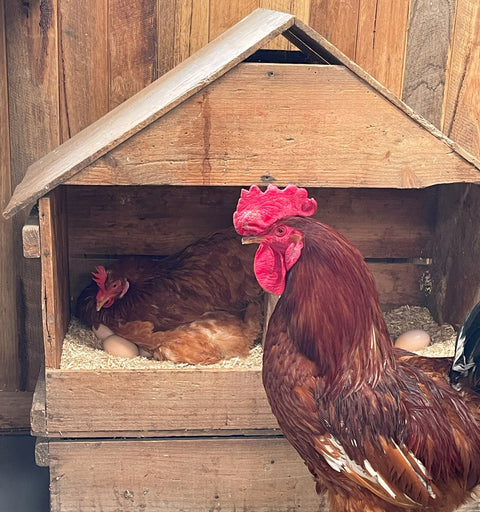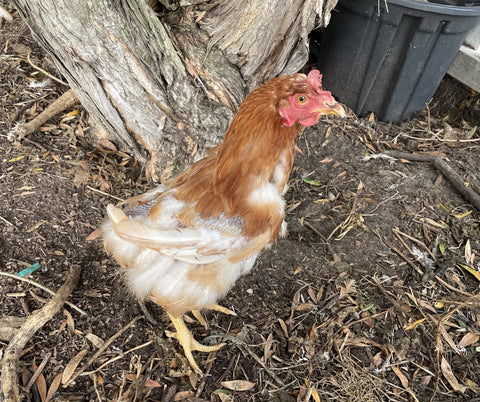While letting your chickens sleep in nesting boxes might seem like a minor issue, it's important to understand the potential consequences. Encouraging proper roosting habits is essential for maintaining a hygienic environment, ensuring egg safety and promoting overall flock health.
The Importance of Hygiene and Egg Quality
Chickens naturally produce a large amount of manure while they sleep - up to ⅓ are done. When droppings accumulate in nesting boxes, they create a breeding ground for harmful bacteria and pathogens. These contaminants can easily transfer to your fresh eggs posing a significant health risk to your family. Additionally, nesting boxes filled with droppings increase the likelihood of eggs being accidentally cracked or trampled which further risks bacteria entering eggs.
This compromised hygiene translates into more time and effort spent on your part. You'll need to clean the nest boxes more frequently, replace soiled bedding regularly and carefully inspect eggs for contamination every time you collect them. All of this adds up to increased costs and the potential loss of perfectly good eggs.
Understanding Why Chickens May Choose Nesting Boxes
There are several reasons why chickens might opt to sleep in nesting boxes instead of using their designated roosting perches. By carefully observing your flock and examining your coop setup you can likely pinpoint the root cause:
- Height and Placement: Chickens have an innate instinct to seek higher ground for sleeping as it offers a sense of security from potential predators. If your nesting boxes are situated higher than the perches, your hens will naturally gravitate toward the more elevated spot.
- Accessibility: The design of your perches plays a crucial role. If they are too high for certain breeds, such as Silkies or other bantams with limited flight capabilities, these chickens may find it difficult to access them.
- Space and Comfort: Overcrowded roosting perches can lead to squabbles and discomfort, discouraging some hens from using them altogether. Ensure there's ample perch space for your entire flock to roost comfortably.
- Cleanliness: Chickens prefer a clean roosting environment. A buildup of droppings on the perches will make them less appealing and might encourage hens to seek alternative sleeping spots.
- External Factors: The presence of a dominant bully within the flock can make other hens feel unsafe on the communal perches. Similarly, an infestation of red mites with their nocturnal biting habits, will deter any chicken from wanting to roost.
Strategies for Promoting Healthy Roosting Habits
The following solutions can effectively train your chickens to adopt healthier sleeping practices:
- Temporary Nest Box Closure: Block access to the nesting boxes in the late afternoon and evening. This simple action will encourage your hens to seek out the perches for their night-time roosting routine. Remember to reopen the boxes after dark or in the morning so they are ready for egg-laying.
- Reconsider Placement: Always ensure your perches are positioned higher than the nesting boxes. You might need to physically lower the nest boxes or raise the perches.
- Adequate Perch Options: Provide multiple perches at varying heights to suit different breeds. If you suspect bullying, adding additional perches away from the main roosting area can offer a safe space for intimidated hens.
- Maintain Perch Hygiene: Use a good scraper to regularly clean-off any deposits of droppings from your perches and other internal surfaces within the coop. A clean roosting environment is far more inviting for your chickens.
- Inspect for Mites: If you find evidence of red mites, take immediate action. These parasites can cause significant discomfort, driving your hens away from the perches. A thorough cleaning of the coop and treatment with products like Wipe Out Mites and Bugs Away over a 7-day period are essential.
- Nest Box Modification: Design your nest boxes with a sloped roof to prevent chickens from comfortably perching or roosting on top. Make sure there’s a deep layer of hemp fiber in each nest box of around 15cm. Hemp is far-more absorbent than straw or hay and has natural antibacterial qualities not found in other forms of nest or bedding materials. Darken your nests by attaching a curtain over the open face of the nest with a 4cm gap for hens to poke their head through and see how inviting it looks.
Optimal Perch Design
When constructing or selecting your perches, consider these design factors for maximum comfort and appeal:
- Graduated Heights: Offer a range of heights, starting at approximately 20cm off the ground and increasing in 22cm increments.
- Comfortable Width: Flat perches with slightly rounded edges are ideal. Aim for a width of at least 4cm.
- Ample Spacing: Allocate approximately 30cm of perch space per hen to prevent overcrowding.
It's Worth the Effort!
By taking this proactive approach, you'll be promoting a healthier and more hygienic environment for your backyard chickens while ensuring the quality and safety of your fresh eggs.







Comments (2)
For about 10 days I physically lifted the new girls onto their perch. (I was already closing access to the nesting boxes but they were opting for the floor of their house not the perch.) They are now happily going straight to the perch. I’m still closing off the nesting boxes in the afternoon but probably don’t need to do that now. I’ll keep closing off the nesting the nesting boxes for another week or so to make sure the good behaviour is ingrained.